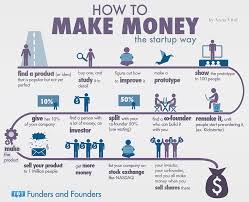Are you wondering how to start a company and grow your income?
A company is a legal entity formed to conduct business activities. Its function in income growth involves producing and selling goods or services, thereby generating revenue and profit. This income drives business expansion, job creation, and economic development, contributing to overall income growth for individuals and communities.
In this article, we will show you how to start a company and grow your income easily.
What is a Company?
Starting a company is an exciting venture that involves transforming an idea into a structured, functioning business. At its core, a company is an organization formed to engage in commercial, industrial, or professional activities. Companies can vary significantly in size, scope, and industry, but they all share the common goal of generating revenue and creating value.
Definition and Purpose
A company is a legal entity formed by a group of individuals to engage in and operate a business. The primary purpose of starting a company is to provide goods or services to customers while generating profits for the owners or shareholders. Entrepreneurs start companies to innovate, solve problems, and meet market demands, driving economic growth and creating job opportunities.
Key Reasons for Starting a Company
- Independence: Many entrepreneurs seek the freedom to be their own boss and make independent decisions about their business.
- Financial Rewards: Owning a company can be financially rewarding, offering the potential for significant profits and long-term wealth.
- Innovation: Starting a company allows individuals to bring innovative products or services to market, fulfilling unmet needs.
- Passion: Entrepreneurs often start companies to pursue their passions and interests, turning hobbies or ideas into viable businesses.
- Impact: Companies can have a positive impact on society by creating jobs, driving economic growth, and addressing social and environmental challenges.
Types of Companies
There are several types of companies, each with its own legal structure and implications:
- Sole Proprietorship: Owned and operated by one individual, with no legal distinction between the owner and the business.
- Partnership: Owned by two or more individuals who share profits, losses, and responsibilities.
- Limited Liability Company (LLC): Offers limited liability protection to its owners while providing flexibility in management and taxation.
- Corporation: A separate legal entity owned by shareholders, offering limited liability and the ability to raise capital through stock.
How to Start a Company With a Proper Research
Market research is a critical step in starting a company, providing valuable insights into your target market, competition, and industry trends. By conducting thorough market research, you can make informed decisions, reduce risks, and increase the likelihood of your company’s success.
Importance of Market Research
Market research helps you understand the needs and preferences of your potential customers, identify market opportunities, and develop effective business strategies. It allows you to validate your business idea, estimate demand, and refine your product or service offering. Additionally, market research can reveal potential challenges and threats, enabling you to devise strategies to mitigate them.
Identifying Your Target Market
Your target market consists of the specific group of consumers who are most likely to buy your product or service. To identify your target market, consider factors such as demographics (age, gender, income, education), psychographics (lifestyle, values, interests), and geographic location. By understanding who your customers are, you can tailor your marketing efforts to reach and engage them effectively.
Methods for Conducting Market Research
- Surveys: Collect quantitative data by asking potential customers questions about their preferences, needs, and behaviors. Surveys can be conducted online, over the phone, or in person.
- Focus Groups: Gather qualitative insights by engaging a small group of people in discussions about your product or service. This method allows you to explore customers’ attitudes, perceptions, and motivations in depth.
- Industry Reports: Utilize reports and studies published by market research firms, trade associations, and government agencies to gain an understanding of market size, trends, and forecasts.
- Competitor Analysis: Study your competitors to identify their strengths, weaknesses, and strategies. Analyze their products, pricing, marketing tactics, and customer feedback to find opportunities for differentiation.
Analyzing Competitors and Industry Trends
Understanding your competition and industry trends is crucial for positioning your company in the market. Identify your direct and indirect competitors, and evaluate their market share, strengths, and weaknesses. Stay informed about industry developments, technological advancements, and regulatory changes that may impact your business.
By conducting comprehensive market research, you can gain the insights needed to develop a strong business strategy, differentiate your company, and meet the needs of your target market effectively.
Creating a Business Plan
A well-crafted business plan is a roadmap for your company’s growth and success. It outlines your business goals, strategies, and the steps you will take to achieve them. A business plan is not only essential for securing funding but also for guiding your decision-making and measuring your progress.
Components of a Business Plan
- Executive Summary: This is a concise overview of your business plan, highlighting the key points. It should include your business name, location, mission statement, product or service offerings, and basic financial information. Although it appears first, it’s often written last to encapsulate the entire plan.
- Business Description: Provide detailed information about your business, including the industry background, company history, and the problem your product or service solves. Explain your business model and what makes your company unique.
- Market Analysis: Summarize your market research findings. Include information about your target market, customer demographics, market needs, and trends. Conduct a SWOT analysis (Strengths, Weaknesses, Opportunities, Threats) to identify where your business stands in the market.
- Organization and Management: Outline your business structure, detailing the ownership, management team, and board of directors if applicable. Include profiles of key team members, highlighting their expertise and roles within the company.
- Products or Services: Describe your products or services in detail. Explain the benefits to customers, the product lifecycle, and any research and development activities. If applicable, include information on patents or trademarks.
- Marketing and Sales Strategy: Detail how you plan to attract and retain customers. Discuss your pricing strategy, sales tactics, and promotional activities. Explain your distribution plan and any partnerships that will help you reach your target market.
- Financial Plan and Projections: Provide financial statements, including income statements, cash flow statements, and balance sheets. Include projections for at least three to five years, detailing expected revenue, expenses, and profitability. Highlight your funding requirements and how you plan to use the funds.
Setting Business Goals and Objectives
Clearly define your short-term and long-term goals. Ensure they are Specific, Measurable, Achievable, Relevant, and Time-bound (SMART). Outline the key milestones you need to achieve and the metrics you will use to track your progress.
Importance of Financial Planning and Projections
Financial planning helps you understand your business’s financial health and future profitability. Accurate projections enable you to plan for growth, manage cash flow, and attract investors. Regularly update your financial plan to reflect changes in the market and your business operations.
Tips for Writing a Compelling Business Plan
- Be Clear and Concise: Avoid jargon and overly technical language. Present your information clearly and logically.
- Focus on Your Unique Selling Proposition: Highlight what sets your business apart from competitors.
- Use Data and Evidence: Support your claims with data from your market research and industry analysis.
- Review and Revise: Continuously update your business plan as your company grows and market conditions change.
A comprehensive business plan provides a strategic framework for starting and growing your company, ensuring you stay focused on your objectives and are prepared to navigate challenges along the way.
Legal Considerations and Registration
Starting a company involves navigating various legal requirements and ensuring compliance with local, national, and international laws. Understanding these legal considerations is crucial for protecting your business and avoiding potential legal issues.
Steps to Legally Register Your Company
- Choose a Business Name: Select a unique and memorable name that reflects your brand. Ensure it is not already in use by another entity by conducting a thorough name search.
- Determine Your Business Structure: Decide on the legal structure of your company (e.g., sole proprietorship, partnership, LLC, corporation). Each structure has different legal and tax implications.
- Register Your Business: Register your company with the appropriate government authorities. This process varies by country and may involve filing specific forms and paying registration fees. In many countries, you may need to register with multiple agencies, such as the local, state, and federal governments.
- Obtain an Employer Identification Number (EIN): In many jurisdictions, businesses must obtain an EIN or equivalent tax identification number. This number is used for tax reporting and other official purposes.
- Register for Taxes: Register for the necessary taxes, such as income tax, sales tax, and value-added tax (VAT). Ensure you understand your tax obligations and deadlines.
Choosing the Right Business Structure
Your choice of business structure affects your liability, taxes, and ability to raise capital. Common structures include:
- Sole Proprietorship: Simple and inexpensive to establish, but the owner is personally liable for business debts.
- Partnership: Involves two or more people sharing profits, losses, and responsibilities. Partners are personally liable.
- Limited Liability Company (LLC): Offers limited liability protection to owners while providing flexibility in management and taxation.
- Corporation: A separate legal entity that provides limited liability protection and the ability to raise capital through stock. However, it involves more regulations and higher setup costs.
Understanding Regulations
Comply with all relevant regulations, including labor laws, environmental regulations, and industry-specific rules. Failing to adhere to these can result in fines, legal action, and damage to your company’s reputation.
Licenses and Permits
Depending on your industry and location, you may need various licenses and permits to operate legally. Common examples include:
- Business License: General license required to operate a business.
- Health and Safety Permits: Necessary for businesses involved in food production, healthcare, and other industries with specific health and safety standards.
- Environmental Permits: Required for businesses that have environmental impacts, such as manufacturing or waste management.
Intellectual Property Protection
Protect your intellectual property (IP), such as trademarks, patents, and copyrights, to safeguard your brand and innovations. Registering your IP can prevent others from using your creations without permission.
Navigating the legal aspects of starting a company can be complex, but ensuring compliance with all regulations and protecting your business legally is essential for long-term success.
Securing Funding for Your Company
Securing funding is a crucial step in starting and growing your company. Adequate capital allows you to cover startup costs, sustain operations, and invest in growth opportunities. There are various sources of funding available, each with its own advantages and considerations.
Different Sources of Funding
- Personal Savings: Using your own money is often the simplest and least risky way to fund your business. It allows you to retain full control and avoid debt or equity dilution.
- Loans: Business loans from banks or financial institutions can provide significant capital. Options include traditional bank loans, Small Business Administration (SBA) loans, and microloans. Be prepared to present a solid business plan and demonstrate your ability to repay the loan.
- Investors: Attracting investors, such as venture capitalists or angel investors, can provide substantial funding. Investors typically seek equity in your company in exchange for their investment. This can dilute your ownership but brings valuable expertise and connections.
- Crowdfunding: Platforms like Kickstarter, Indiegogo, and GoFundMe allow you to raise small amounts of money from a large number of people. Successful crowdfunding campaigns not only provide funds but also validate your business idea and build a customer base.
- Grants and Competitions: Various government agencies, non-profits, and private organizations offer grants and business competitions that award funding. These are often highly competitive but do not require repayment or equity.
Creating a Pitch for Potential Investors
A compelling pitch is essential for attracting investors. Your pitch should include:
- Elevator Pitch: A brief, engaging summary of your business idea.
- Problem and Solution: Clearly articulate the problem your company solves and how your product or service addresses it.
- Market Opportunity: Present data on your target market and growth potential.
- Business Model: Explain how your company will generate revenue and achieve profitability.
- Financial Projections: Provide realistic financial forecasts and key metrics.
- Team: Highlight the expertise and experience of your team members.
- Use of Funds: Specify how the investment will be used to grow the business.
Crowdfunding and Alternative Funding Options
Crowdfunding can be an effective way to raise funds while building a community of supporters. There are different types of crowdfunding:
- Reward-Based Crowdfunding: Backers receive a reward, such as a product or service, in exchange for their contribution.
- Equity Crowdfunding: Investors receive equity in the company in exchange for their investment.
- Debt Crowdfunding: Businesses raise funds by borrowing from a group of individuals, who receive interest on their loans.
Exploring these funding options and preparing a strong pitch will help you secure the necessary capital to launch and grow your company successfully.



